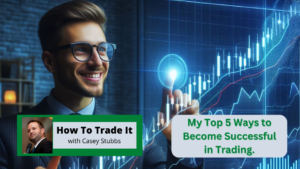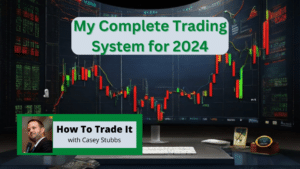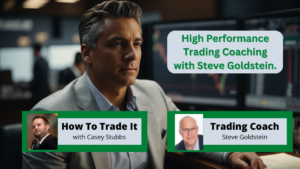The Basics of Selling Options with Scott Williams, Ep #45

Most options traders buy a call or a put. With a call option, you want the stock price to go up. If you buy the put option, you want the stock price to go down. It’s the way most options traders trade. But what if you want to be on the other side and sell options? What are the best strategies to maximize your wins and minimize your losses? In this episode of How To Trade It, Scott Williams—the President and Co-Founder of Relentless Trading—sheds some light on selling options. Don’t miss it!
In this episode of How To Trade It, Scott Williams—the President and Co-Founder of Relentless Trading—sheds some light on selling options. Don’t miss it! #stocks #stock #trading #StockMarket #Investing #DayTrading #StockPicks #OptionsTrading… Click To Tweet
Subscribe to How To Trade It
[maxbutton id=”3″][maxbutton id=”4″][maxbutton id=”5″][maxbutton id=”6″]
You’ll want to hear this episode if you are interested in…
- [1:42] How Scott got started in trading.
- [3:15] How Scott learned options trading.
- [7:31] Selling options for a premium.
- [13:48] Selling a put option.
- [15:54] Shoot for a high winning percentage.
- [21:26] How to handle volatile markets.
- [27:11] More about Relentless Trading.
Scott’s journey in options trading
Scott dove in on YouTube to learn everything he could. He won his first couple of trades, then lost the next few. He spent a few years on a roller coaster ride. At the time, he only bought short-term options contracts. He didn’t know what he was doing, so the timing was killing him. As we’ve discussed before, timing is a key component of any successful trading strategy. His risk-management was terrible and he had no plan. Sometimes he was risking 25% of his account. He didn’t set price targets. He lacked trading discipline and structure.
Scott was willing to lose to get the education. But he experimented with strategies in his live account and experienced great losses—one of which was $25,000. Those losses are humbling but then you have to come back.
How did he respond and recover? Research, back-testing, and working in a paper account. He needed to set rules for his trading strategies. Because he didn’t have them, he didn’t have anything to follow. He needed to educate himself on where mistakes were made and decide where to make changes.
So he decided to get some professional help. In a seminar he attended, he realized he was making every mistake. When he took additional courses (a $20,000 package over the span of 14 months), they talked about the other side of options trading: selling.
Selling options for a premium
If you’re the option seller, you want the stock price to drop or stay below the strike price. As long as it does, he collects the premium. You’re selling something that you don’t own, which can be difficult to understand.
Scott shares an example that makes it easier to understand: Say you’re holding 10,000 shares of Apple stock (AAPL). If Apple stock tanks, you don’t want to take a hit. But you also don’t want to sell the shares. So you buy a protective put. So if the stock drops, you make some of the loss back. You’re buying yourself insurance to protect your shares.
The seller is the insurance company. If the “car” crashes, the insurance pays you for your loss. If your car is fine month after month, the insurance company (you) simply collects a premium. Statistically, you win more than you lose.
What’s the best strategy for selling options? Scott Williams—the President and Co-Founder of Relentless Trading—shares his strategy in this episode of How To Trade It! #stocks #stock #trading #StockMarket #Investing #DayTrading #StockPicks… Click To Tweet
Scott’s options selling strategy
Scott likes to trade credit spreads. So he sells one and buys another as insurance for himself to cap his losses. In this type of trade, the ideal scenario is for the market to go sideways—usually. But Scott plays it differently. Much of his strategy is based on price action. He looks at a one-year/one-day chart for a macro trend. If it’s consistently going up and isn’t peaking, he would sell a bull-put spread below that. As long as it stays above his line, he’s good.
If the market is in a downward trend, he’d purchase a bear-call spread. So as long as it stays below his line, he’s good. In a neutral market, he’ll sell both and box it in (called an “Iron Condor”). If it stays between both of those lines, he wins on both trades.
When you’re selling spreads, you’re looking for a high winning percentage, not risk to reward ratio. But it depends on your strategy. Scott usually gets an 85-90% win-rate. If he hits a loss, he’s still running good risk management. He believes a max loss should be set at 5% of your total account balance at the most.
Why Scott relies on this options selling strategy
Scott shoots for $1,000 in and $100 out. He runs between 15-30 trades in that range. They’re easier to manage because they’re more passive. Each of his trades is typically a 30-day trade. You get $100 back at the end of the month. Every Friday as a trade expires, you take the money from the options that expired and reallocate it into the next trade.
He can find a trade and place it in 15 minutes. If he sets a stop-loss at that point, he has nothing else to do. It either expires and he makes a profit or he doesn’t. There’s no real ongoing trade management required—unless he places bullish trades and senses the market will change. Then, he will close his trades early and cut his losses and sit on the sidelines.
How does Scott handle volatile markets? What do you do when situations like the Covid-19 pandemic arise? Listen to the whole episode to learn more about selling options.
How do you handle volatile markets when you’re selling options? Scott Williams shares his take in this episode of How To Trade It. Check it out! #stocks #stock #trading #StockMarket #Investing #DayTrading #StockPicks #OptionsTrading #options Click To Tweet
Connect with Scott Williams
- Get 25% off of Scott’s training course if you use the code “CASEY25.”
- Relentless Trading
- Friend on Facebook
- Watch on YouTube
- Connect on LinkedIn
Connect With Casey Stubbs
- Website: https://caseystubbs.com
- YouTube: https://www.youtube.com/TradingStrategyGuides
- YouTube: https://www.youtube.com/caseystubbs
- Twitter: https://www.twitter.com/caseystubbs
- Facebook: https://www.facebook.com/TradingStrategyGuides
- LinkedIn: https://www.linkedin.com/in/caseystubbs/
- Newsletter: https://tradingstrategyguides.ewebinar.com/webinar/live-workshop-learn-the-simple-baseline-strategy-13152
Subscribe to How To Trade It
Disclaimer: Trading carries a high level of risk, and may not be suitable for all investors. Before deciding to invest you should carefully consider your investment objectives, level of experience, and risk appetite. The possibility exists that you could sustain a loss of some or all of your initial investment. Therefore you should not invest money that you cannot afford to lose. You should be aware of all the risks associated with foreign exchange trading, and seek advice from an independent financial advisor if you have any doubts.







